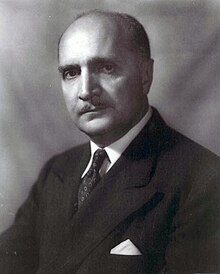Loy W. Henderson
| Loy W. Henderson | |
|---|---|
 |
|
| United States Ambassador to Iran | |
|
In office 1951–1954 |
|
| President | Dwight D. Eisenhower |
| Preceded by | Selden Chapin |
| Succeeded by | Henry F. Grady |
| United States Ambassador to India | |
|
In office 1948–1951 |
|
| President | Harry S. Truman |
| Preceded by | Chester Bowles |
| Succeeded by | Henry F. Grady |
| United States Minister to Iraq | |
|
In office 1943–1945 |
|
| President | Franklin D. Roosevelt |
| Preceded by | George Wadsworth II |
| Succeeded by | Thomas M. Wilson |
| Personal details | |
| Born |
June 28, 1892 Rogers, Arkansas |
| Died | March 24, 1986 (aged 93) |
Loy Wesley Henderson (June 28, 1892 – March 24, 1986) was a United States Foreign Service Officer and diplomat.
Henderson was born in Rogers, Arkansas in 1892 to a poor Methodist preacher. He attended college in a small town in Kansas before transferring to Northwestern University. An arm injury prevented him from fighting in World War I, so he served as a Red Cross volunteer instead.
Henderson joined the United States Department of State in 1922. After his initial consular tour in Ireland, he began a twenty-year focus on Soviet and Eastern European Affairs. Henderson then investigated the connection between the Soviet Comintern and left wing organizations in the United States while serving in Latvia, Lithuania, and Estonia.
In 1933, the Roosevelt Administration extended diplomatic recognition to the Soviet Union and Henderson was assigned to Russia to help reopen the U.S. Embassy in Moscow. Aiding him in this task were fellow junior officers George F. Kennan and Charles Bohlen, who along with Henderson would later be considered the Department's top Soviet specialists. In 1935, the Kremlin broke its pledge to not to interfere in U. S. domestic politics. In response, Ambassador Bullitt returned to Washington in disgust, leaving Henderson for a time as chargé d'affaires in Moscow. As chargé, Henderson warned Washington that the Soviet Union was likely to cooperate with Nazi Germany. Four years later, Moscow signed the Soviet-German Non-aggression Pact of 1939. Henderson was one of the contributors to the Welles declaration of 1940, which established US non recognition policy of Baltic states occupation by Soviet Union.
Henderson deeply distrusted the Kremlin and was at odds with the enthusiasm most Americans—and President Roosevelt—had in early 1942 for their new Soviet wartime allies. Eleanor Roosevelt and other Soviet sympathizers in the White House pressured the State Department to transfer Henderson out of the Soviet section. As a result, Henderson was sent to Baghdad as the U.S. ambassador to Iraq. "A man of the highest character, absolutely incorruptible....Overruled time after time, he asked in 1943 to be relieved of his duties as chief of the division".
...
Wikipedia
